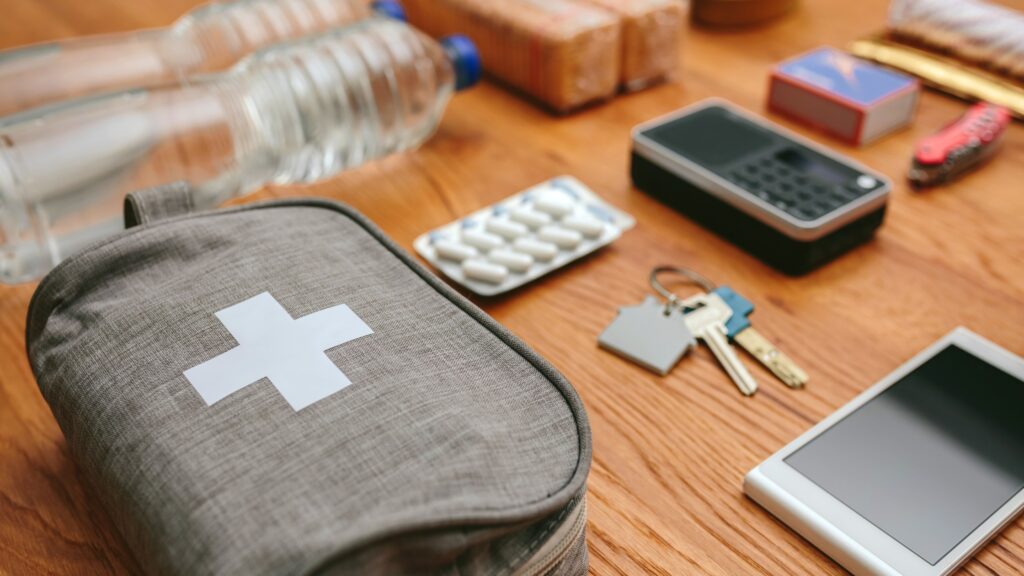In an unpredictable world, being prepared can make all the difference when disaster strikes. From natural calamities to unforeseen emergencies, having a solid plan in place ensures your family’s safety and well-being.
This guide explores six essential disaster preparedness tips tailored for families, emphasizing proactive measures and strategic planning to navigate through challenging times effectively.
Key Takeaways
- Have a clear plan with an out-of-area contact to stay connected during emergencies.
- Keep a stocked kit with essentials like food, water, medications, and important documents. Update it regularly.
- Regularly practice evacuation routes and emergency procedures as a family.
- Stay updated on local hazards and alerts through reliable sources.
- Consider and prepare for the unique needs of family members, including pets or medical conditions.
Disaster Preparedness Tips for Families
1. Create a Communication Plan
Establishing a communication plan is crucial during emergencies when local communication channels might be disrupted. Designate an out-of-area contact whom every family member can reach. This person should be someone trusted and easily reachable, such as a relative or friend residing in another city or state.
Ensure everyone in the family has this contact’s phone number memorized or written down in a secure location. Agree on a communication method—such as text messaging or social media—that everyone can use to check in and relay information. It’s also wise to have a backup communication plan in case the primary method fails, such as using a landline or radio communication.
This plan ensures that even if family members are separated during a disaster, everyone knows how to stay in touch and coordinate their actions effectively.
2. Build an Emergency Kit

An emergency kit is essential to sustain your family’s basic needs during and after a disaster. Include non-perishable food items that require minimal preparation, such as canned goods, protein bars, and dried fruits. Store at least one gallon of water per person per day, with enough for at least three days.
Include a manual can opener, basic utensils, and a portable stove or heating source if possible. A comprehensive first aid kit with essential medical supplies and medications is crucial. Ensure the kit includes any prescription medications your family members require regularly.
Don’t forget to include copies of important documents such as identification papers, insurance policies, and medical records in a waterproof container. Periodically check and update your emergency kit to ensure all supplies are in good condition and within expiration dates.
3. Plan Escape Routes
Identify primary and alternative escape routes from your home and neighborhood in case of emergencies like fires or earthquakes. Conduct practice drills with your family members to familiarize everyone with these routes. Ensure all exits are accessible and clear of obstacles.
Designate meeting points both within your neighborhood and outside it to reunite if separated during an emergency evacuation. Discuss and agree upon a communication plan to notify each other when safely evacuated to the designated meeting point. Consider any special needs or limitations of family members, such as young children or elderly relatives, and incorporate them into your escape plan.
Practicing these drills regularly ensures that everyone knows what to do and can evacuate quickly and safely when necessary.
RELATED: Best Smoke Detectors
4. Stay Informed
Staying informed about potential hazards in your area is crucial for effective disaster preparedness. Monitor local news channels, weather reports, and alerts from emergency management agencies to stay updated on developing situations.
Sign up for emergency alerts and notifications on your mobile phone or email to receive timely information and instructions from local authorities. Understand the specific risks and evacuation procedures relevant to your location, such as flood zones, earthquake-prone areas, or wildfire risks.
Educate yourself and your family members about the signs and warnings of different types of disasters so you can respond appropriately. Being informed allows you to make informed decisions and take necessary actions to protect your family’s safety during emergencies.
5. Practice Emergency Drills

Regularly conducting emergency drills with your family helps ensure everyone knows what to do and how to react in various disaster scenarios. Practice drills for different emergencies such as fires, earthquakes, severe storms, or evacuation procedures specific to your area.
Assign roles and responsibilities to each family member, such as who will gather emergency supplies, who will assist children or elderly relatives, and who will handle communication with the out-of-area contact. Review and update your emergency plans based on the outcomes of these drills to address any gaps or areas needing improvement.
Use drills as opportunities to reinforce safety procedures and ensure everyone remains calm and focused during a real emergency.
6. Prepare for Specific Needs
Consider the unique needs of your family members when preparing for emergencies. Take into account any medical conditions, disabilities, or special dietary requirements that require specific supplies or accommodations in your emergency kit.
Ensure you have an adequate supply of medications, medical equipment, or assistive devices needed by family members. Plan for the care and safety of pets or service animals during emergencies by including pet food, water, carriers, and vaccination records in your emergency supplies.
Discuss emergency plans with family members to address any concerns or challenges related to specific needs and incorporate them into your overall preparedness strategy. Being proactive in addressing these specific needs ensures that everyone in your family can safely endure and recover from a disaster situation.
The Bottom Line
Prioritizing disaster preparedness is not just about planning for the worst-case scenarios; it’s about safeguarding the ones we hold dear. By following these six crucial disaster preparedness tips tailored for families—creating a robust communication plan, building a comprehensive emergency kit, planning escape routes, staying informed, practicing emergency drills, and accommodating specific needs—we empower ourselves to face adversity with resilience and foresight.
Disasters can disrupt our lives in profound ways, but with preparation and practice, we can mitigate their impact and protect what matters most. Remember, preparedness is a continuous journey.
FAQs
What should be included in a basic emergency kit for families?
A basic emergency kit should include essentials such as non-perishable food (enough for at least 3 days), water (one gallon per person per day), a first aid kit, medications, flashlight with extra batteries, a multi-tool, personal hygiene items, copies of important documents (IDs, insurance policies), and cash.
How often should we update our emergency kit?
It’s recommended to review and update your emergency kit at least twice a year. Check expiration dates on food, medications, and batteries, and replace any items that may have expired. Also, update the kit to reflect any changes in family needs or seasonal considerations.
What should we include in our family communication plan?
A family communication plan should include contact information for an out-of-area emergency contact that everyone in the family can reach. Decide on a method of communication (e.g., text messages, social media) and establish protocols for checking in and sharing information during emergencies when local communication may be disrupted.
How can families practice and prepare for emergencies?
Families can practice for emergencies by conducting regular drills. Practice evacuation routes from your home and designate meeting points both within your neighborhood and outside it. Assign roles and responsibilities to each family member and practice procedures for different types of emergencies, such as fires, earthquakes, or severe weather.
What should families with young children or elderly members consider in their disaster preparedness plans?
Families with young children or elderly members should consider their specific needs when preparing for emergencies. This includes having extra supplies such as diapers, formula, or special medications. Ensure that evacuation plans and emergency kits are tailored to accommodate these needs and that caregivers are aware of their responsibilities during emergencies.
What’s in a Family Emergency Plan?
A Family Emergency Plan typically includes essential information and preparations to ensure everyone in the household knows what to do in case of an emergency. Here are some key components typically found in such a plan:
Communication Plan: Contact information for all family members, including work, school, and mobile numbers. Designate an out-of-area contact that everyone can reach if local communications are disrupted.
Emergency Contacts: Include numbers for local emergency services (police, fire department, ambulance) and utilities (gas, water, electricity).
Evacuation Plan: Identify multiple evacuation routes from your home and establish a meeting point outside the home where everyone can gather safely.
Medical Information: List any medical conditions, medications, and allergies for each family member. Keep copies of health insurance cards and identification.


